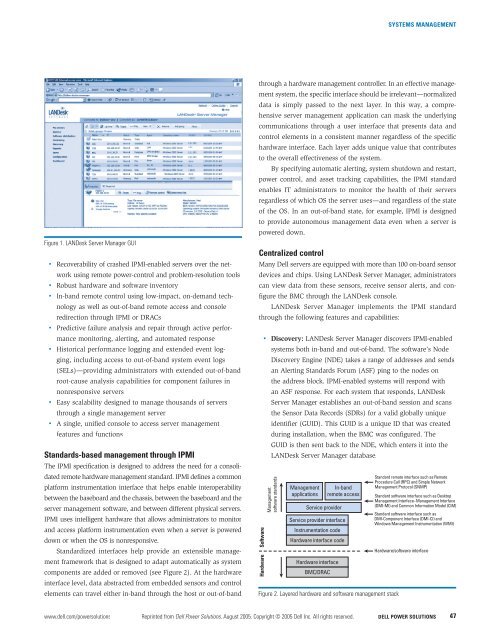POWER SOLUTIONS
POWER SOLUTIONS
POWER SOLUTIONS
Create successful ePaper yourself
Turn your PDF publications into a flip-book with our unique Google optimized e-Paper software.
SYSTEMS MANAGEMENTFigure 1. LANDesk Server Manager GUI• Recoverability of crashed IPMI-enabled servers over the networkusing remote power-control and problem-resolution tools• Robust hardware and software inventory• In-band remote control using low-impact, on-demand technologyas well as out-of-band remote access and consoleredirection through IPMI or DRACs• Predictive failure analysis and repair through active performancemonitoring, alerting, and automated response• Historical performance logging and extended event logging,including access to out-of-band system event logs(SELs)—providing administrators with extended out-of-bandroot-cause analysis capabilities for component failures innonresponsive servers• Easy scalability designed to manage thousands of serversthrough a single management server• A single, unified console to access server managementfeatures and functionsStandards-based management through IPMIThe IPMI specification is designed to address the need for a consolidatedremote hardware management standard. IPMI defines a commonplatform instrumentation interface that helps enable interoperabilitybetween the baseboard and the chassis, between the baseboard and theserver management software, and between different physical servers.IPMI uses intelligent hardware that allows administrators to monitorand access platform instrumentation even when a server is powereddown or when the OS is nonresponsive.Standardized interfaces help provide an extensible managementframework that is designed to adapt automatically as systemcomponents are added or removed (see Figure 2). At the hardwareinterface level, data abstracted from embedded sensors and controlelements can travel either in-band through the host or out-of-bandthrough a hardware management controller. In an effective managementsystem, the specific interface should be irrelevant—normalizeddata is simply passed to the next layer. In this way, a comprehensiveserver management application can mask the underlyingcommunications through a user interface that presents data andcontrol elements in a consistent manner regardless of the specifichardware interface. Each layer adds unique value that contributesto the overall effectiveness of the system.By specifying automatic alerting, system shutdown and restart,power control, and asset tracking capabilities, the IPMI standardenables IT administrators to monitor the health of their serversregardless of which OS the server uses—and regardless of the stateof the OS. In an out-of-band state, for example, IPMI is designedto provide autonomous management data even when a server ispowered down.Centralized controlMany Dell servers are equipped with more than 100 on-board sensordevices and chips. Using LANDesk Server Manager, administratorscan view data from these sensors, receive sensor alerts, and configurethe BMC through the LANDesk console.LANDesk Server Manager implements the IPMI standardthrough the following features and capabilities:Hardware Software• Discovery: LANDesk Server Manager discovers IPMI-enabledsystems both in-band and out-of-band. The software’s NodeDiscovery Engine (NDE) takes a range of addresses and sendsan Alerting Standards Forum (ASF) ping to the nodes onthe address block. IPMI-enabled systems will respond withan ASF response. For each system that responds, LANDeskServer Manager establishes an out-of-band session and scansthe Sensor Data Records (SDRs) for a valid globally uniqueidentifier (GUID). This GUID is a unique ID that was createdduring installation, when the BMC was configured. TheGUID is then sent back to the NDE, which enters it into theLANDesk Server Manager database.Managementsoftware standardsManagementapplicationsService providerIn-bandremote accessService provider interfaceInstrumentation codeHardware interface codeHardware interfaceBMC/DRACFigure 2. Layered hardware and software management stackStandard remote interface such as RemoteProcedure Call (RPC) and Simple NetworkManagement Protocol (SNMP)Standard software interface such as DesktopManagement Interface–Management Interface(DMI-MI) and Common Information Model (CIM)Standard software interface such asDMI-Component Interface (DMI-CI) andWindows Management Instrumentation (WMI)Hardware/software interfacewww.dell.com/powersolutions Reprinted from Dell Power Solutions, August 2005. Copyright © 2005 Dell Inc. All rights reserved. DELL <strong>POWER</strong> <strong>SOLUTIONS</strong> 47








